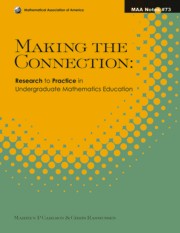Book contents
- Frontmatter
- Preface
- Contents
- Part 1 Student Thinking
- Part 2 Cross-Cutting Themes
- 2a Interacting with Students
- 13 Meeting New Teaching Challenges: Teaching Strategies that Mediate Between All Lecture and All Student Discovery
- 14 Examining Interaction Patterns in College-Level Mathematics Classes: A Case Study
- 15 Mathematics as a Constructive Activity: Exploiting Dimensions of Possible Variation
- 16 Supporting High Achievement in Introductory Mathematics Courses: What We Have Learned from 30 Years of the Emerging Scholars Program
- 2b Using Definitions, Examples and Technology
- 17 The Role of Mathematical Definitions in Mathematics and in Undergraduate Mathematics Courses
- 18 Computer-Based Technologies and Plausible Reasoning
- 19 Worked Examples and Concept Example Usage in Understanding Mathematical Concepts and Proofs
- 2c Knowledge, Assumptions, and Problem Solving Behaviors for Teaching
- 20 From Concept Images to Pedagogic Structure for a Mathematical Topic
- 21 Promoting Effective Mathematical Practices in Students: Insights from Problem Solving Research
- 22 When Students Don't Apply the Knowledge You Think They Have, Rethink Your Assumptions about Transfer
- 23 How Do Mathematicians Learn To Teach? Implications from Research on Teachers and Teaching for Graduate Student Professional Development
- About the Editors
17 - The Role of Mathematical Definitions in Mathematics and in Undergraduate Mathematics Courses
from Part 2 - Cross-Cutting Themes
- Frontmatter
- Preface
- Contents
- Part 1 Student Thinking
- Part 2 Cross-Cutting Themes
- 2a Interacting with Students
- 13 Meeting New Teaching Challenges: Teaching Strategies that Mediate Between All Lecture and All Student Discovery
- 14 Examining Interaction Patterns in College-Level Mathematics Classes: A Case Study
- 15 Mathematics as a Constructive Activity: Exploiting Dimensions of Possible Variation
- 16 Supporting High Achievement in Introductory Mathematics Courses: What We Have Learned from 30 Years of the Emerging Scholars Program
- 2b Using Definitions, Examples and Technology
- 17 The Role of Mathematical Definitions in Mathematics and in Undergraduate Mathematics Courses
- 18 Computer-Based Technologies and Plausible Reasoning
- 19 Worked Examples and Concept Example Usage in Understanding Mathematical Concepts and Proofs
- 2c Knowledge, Assumptions, and Problem Solving Behaviors for Teaching
- 20 From Concept Images to Pedagogic Structure for a Mathematical Topic
- 21 Promoting Effective Mathematical Practices in Students: Insights from Problem Solving Research
- 22 When Students Don't Apply the Knowledge You Think They Have, Rethink Your Assumptions about Transfer
- 23 How Do Mathematicians Learn To Teach? Implications from Research on Teachers and Teaching for Graduate Student Professional Development
- About the Editors
Summary
Introduction
One of the earliest subjects of undergraduate mathematics education research was students' difficulties in writing formal mathematical proofs. Some research focused on the heuristics involved in proof-writing, but early attempts to show that the teaching of heuristics and strategies benefited students' proof-writing skills (Bittinger, 1968; Goldberg, 1973) failed to produce statistically significant results. Other difficulties have been identified, including students' weak understanding of logic and/or mathematical concepts and their definitions (cf. Hart, 1986; Moore, 1994). Several recent studies have looked further at students' proof-writing skills (cf. Dreyfus, 1999, Harel & Sowder, 1998; Selden & Selden, 2003); this topic is also addressed in this volume in chapters by Selden & Selden, Harel & Brown, and Zazkis. The purpose of this chapter is to look closely at one topic that arose from research on proof-writing, mathematical definitions, and most importantly, the role that these definitions play in the mathematical enterprise as well as in the teaching of undergraduate mathematics courses.
Mathematical definitions are of fundamental importance in the axiomatic structure that characterizes mathematics. The enculturation of college mathematics students into the field of mathematics includes their acceptance and understanding of the role of mathematical definitions, that the words of the formal definition embody the essence of and completely specify the concept being defined. But definitions also play a role in the students' experiences in mathematics courses themselves, in the sense that definitions are often used as a vehicle toward a more robust understanding of a given concept.
Information
- Type
- Chapter
- Information
- Making the ConnectionResearch and Teaching in Undergraduate Mathematics Education, pp. 223 - 232Publisher: Mathematical Association of AmericaPrint publication year: 2008
Accessibility standard: Unknown
Why this information is here
This section outlines the accessibility features of this content - including support for screen readers, full keyboard navigation and high-contrast display options. This may not be relevant for you.Accessibility Information
- 35
- Cited by
